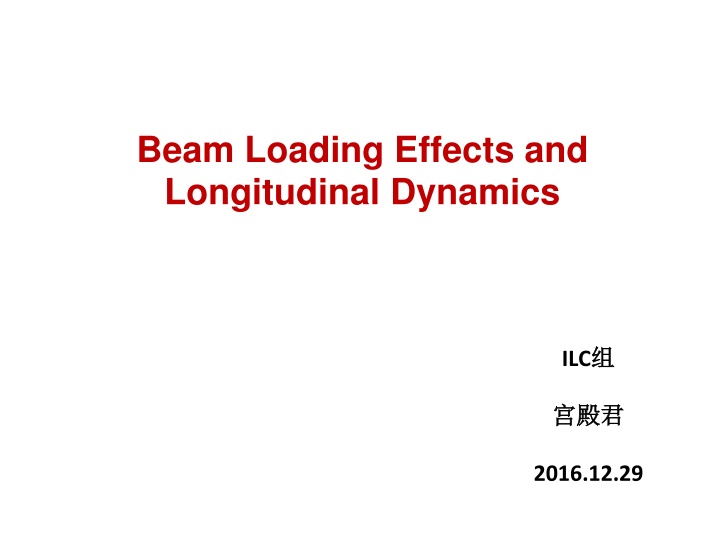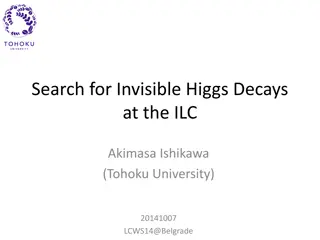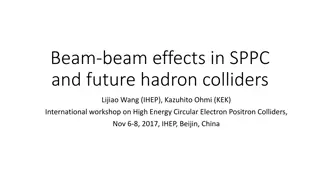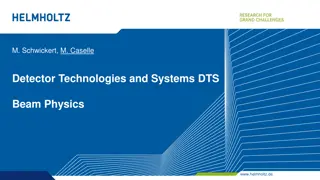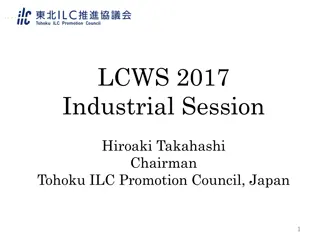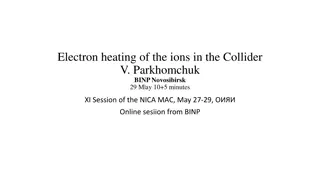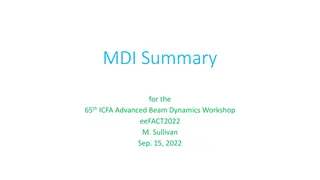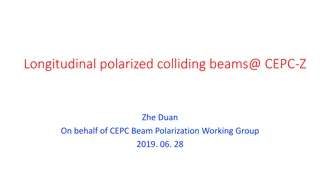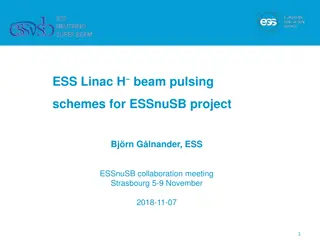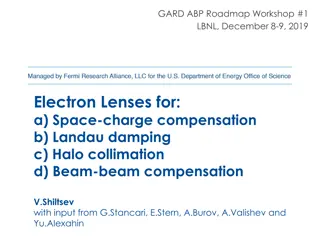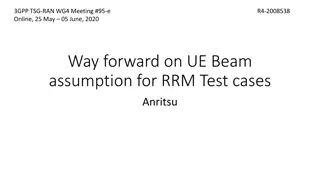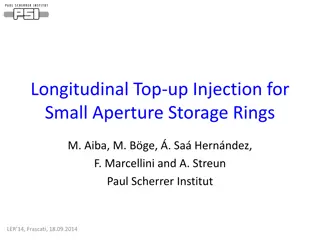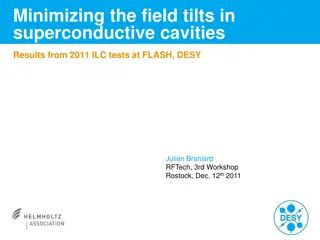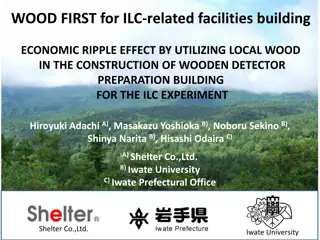Beam Loading Effects and Longitudinal Dynamics in ILC
In this context, delve into the intricate details of beam loading effects and longitudinal dynamics at ILC. Explore the time structure, CEPC parameters, and RF parameters for a single ring, shedding light on the H-PCDR system. Dive into the technical aspects of train spacing, bunch spacing, energy distribution, RF station details, and more, providing valuable insights for the scientific community.
Download Presentation

Please find below an Image/Link to download the presentation.
The content on the website is provided AS IS for your information and personal use only. It may not be sold, licensed, or shared on other websites without obtaining consent from the author.If you encounter any issues during the download, it is possible that the publisher has removed the file from their server.
You are allowed to download the files provided on this website for personal or commercial use, subject to the condition that they are used lawfully. All files are the property of their respective owners.
The content on the website is provided AS IS for your information and personal use only. It may not be sold, licensed, or shared on other websites without obtaining consent from the author.
E N D
Presentation Transcript
Beam Loading Effects and Longitudinal Dynamics ILC 2016.12.29
Time Structure ?+ ? ? ?+ ?? ?? ?? ?0 s s pulse period: ?0= 46.67 Pulse length: ?p=3.3 Train spacing ??= 22.1 Bunch spacing ??=12.1ns(Z), 33.3ns(W), 123.3ns(H-HL), 185ns(H-LP) ?? : s
P Parameter for CEPC sing arameter for CEPC sing ring&partial wangdou20160918 wangdou20160918 ring&partial double ring double ring New-61km H-high lumi. H-low power W Z Number of IPs Energy (GeV) Circumference (km) SR loss/turn (GeV) 2 2 2 2 2 120 61 2.96 15 120 61 2.96 15 80 61 0.58 15 45.5 61 0.061 15 120 61 3.0 Half crossing angle (mrad) 1.88 1.84 5.2 6.4 Piwinski angle Ne/bunch (1011) Bunch number Beam current (mA) SR power /beam (MW) Bending radius (km) Momentum compaction (10-5) IPx/y (m) Emittance x/y (nm) Transverse IP(um) x/IP y/IP VRF(GV) fRF(MHz) Nature z(mm) Total z(mm) HOM power/cavity (kw) Energy spread (%) Energy acceptance (%) Energy acceptance by RF (%) n Life time due to beamstrahlung_cal (minute) F (hour glass) Lmax/IP (1034cm-2s-1) 2.0 107 16.9 50 6.2 1.48 1.98 70 11.0 32.5 6.2 1.48 1.16 400 36.5 21.3 6.2 1.44 0.78 1100 67.6 4.1 6.2 2.9 3.91 54 16.6 50 6.1 3.25 0.43/0.00105 6.28/0.04 51.7/0.2 0.118 0.074 6.99 650 2.19 2.47 3.9 0.13 2.1 6 0.31 34 0.272/0.0013 2.05/0.0062 23.7/0.09 0.041 0.11 3.48 650 2.7 2.95 0.74 0.13 2 2.3 0.35 37 0.275 /0.0013 2.05 /0.0062 23.7/0.09 0.042 0.11 3.51 650 2.7 2.9 0.48 0.13 2 2.4 0.34 37 0.1/0.001 0.93/0.0078 9.7/0.088 0.013 0.073 0.74 650 2.95 3.35 0.88 0.087 0.1/0.001 0.88/0.008 9.4/0.089 0.01 0.072 0.11 650 3.78 4.0 0.99 0.05 1.7 0.49 1.2 0.34 0.82 3.1 0.82 2.01 0.92 4.3 0.93 4.48 0.66 2.02
3 RF parameters for CEPC Single Ring &APDR(8DR) Based on Wang Dou 160918 H-Single single ring 2 2.0 120 3.0 54.8 3.91 / 0 182.7 5.47 273.5 54 / / / 62.56 16.63 / 99.78 / 650 5-cell 6.99 154.6 H-low power 8 double rings 2 2.0 120 2.96 61 2.0 4 3.33 203.3 4.92 19.68 18*4 22.1 3.33 185 32 11.02 172.97 65.24 512.00 650 2-cell 3.51 122.5 H-high lumi 8 double rings 2 3.1 120 2.96 61 2 4 3.33 203.3 4.92 19.68 27*4 22.1 3.33 123.3 32 17.00 259.53 100.66 768.21 650 2-cell 3.48 121.7 W Z Main Ring Type Number of IPs Luminosity/IP Energy (GeV) SR loss/turn (GeV) Circumference (km) Ne/bunch (1011) train number pulse length us revolution time(us) revolution frequency(kHz) pulse frequency kHz bunch number train spacing us pulse length us bunch spacing (ns) bunch charge (nC) beam current mA pulse current(mA) SR power(2 Beams)(MW) pulse power loss (MW) RF frequency(MHz) Cavity Cell number Rf voltage (GV) Synchrotron Phase deg 8 double rings 2 4.3 80 0.58 61 1.16 4 3.33 203.3 4.92 19.68 100*4 22.1 3.33 33.3 18.56 36.53 557.36 42.37 323.27 650 2-cell 0.75 128.4 8 double rings 2 4.5 45.5 0.061 61 0.78 4 3.33 203.3 4.92 19.68 275*4 22.1 3.33 12.1 12.48 67.54 1031.40 8.24 62.92 650 2-cell 0.11 146.3
H-PCDR 2.19 0.13 / 384 1.147 4 12 96 18.20 15.87 4.E+10 514 268 259.8 1.78 3.70 H-low power H-high lumi 2.7 0.13 8 480 0.462 6 10 80 7.31 15.83 2.E+10 206 284 135.9 0.57 0.41 W 3.0 0.087 8 192 0.462 6 4 32 3.91 8.46 2.E+10 206 284 220.7 0.57 0.77 Z 3.8 0.05 8 32 0.462 2 2 16 3.75 8.12 2.E+10 206 284 257.5 0.57 0.92 Nature mm Energy Spread % RF Station Cavity number effective length m cavity/module module/station total module Cavity Voltage(MV) ????(MV/m) Quality Factor Q0 @2K R/Q Geometry Factor G Input Power/Cavity(kw) Loss Factor(V/pC HOM Power/Cavity(kw) 2.7 0.13 8 480 0.462 6 10 80 7.25 15.69 2.E+10 206 284 209.7 0.57 0.62 / 12% 18% 72% 140% maximum voltage decrease(1+1) / 12.8 19 64.3 / maximum phase shift(deg) (1+1) / 3% 4.5% 18% 35% maximum voltage decrease(4+4) / 3.2 4.8 16.7 24.6 maximum phase shift(deg) (4+4) W Z Z 140 bunch
Longitudinal Dynamics ?? ??=?0????sin?? Synchronous particles: 2? ?? ??=??????sin?? Non-synchronous particles: 2? 2 h eV E 2 d dt The longitudinal oscillation equation: 0 rf = (sin sin ) i i s 2 2 2 ith particle Hamitonian eV 1 2 0 rf E = + + 2 [cos cos ( )sin ] H h 0 s s s 2 2 The separatrix ???? ?2+ ??2?? ?[cos? + cos?? (? ? ??)sin??] = 0
RF bucket APDR Higgs low power APDR Higgs high lumi 57.5 < ? < 156.3 58.3 < ? < 154.7
APDR W: APDR Z: 51.6 < ? < 169.1 33.7 < ? < 209.5
BEPCII SR light : Collider :
CEPC APDR 8DR 20160918 BEPCII Higgs-LP Higgs-HL W Z Collider SR Light Energy GeV 120 120 80 45.5 1.89 2.5 ???(GV) 3.51 3.48 0.75 0.11 1.5MV 1.5MW ??(deg) 122.5 121.7 128.4 146.3 174.8 165.1 Voltage Decrease% 3 4.5 18 35 0.3 0.065 Phase Shift (deg) 3.2 4.8 16.7 24.6 0.23 0.063 RF bucket (deg) 122.5-156.3 58.3-154.7 51.6-169.1 33.7-209.5 5.2-301.8 14.9-261.8 Bucket area A (MeV) 0.84 0.85 0.79 0.56 2.30E-4 1.65E-4 2 EeV 1 sin 1 sin + (?, ? rf = 1/2 ) A 16( s ?0) (t, ?) 2 2 h 0 s
RF Energy Acceptance ???= |?max ?0 | = ??? ?0?(?) ?0 ?(?) = 2( ?2 1 arccos(1 ?)) 1 ?= ?0 ???? ?0 tan2? ? 1 ??? ?0 2 ? ???=
For Higgs-high lumi, RF energy acceptance will decrease from 2.3% to 1.7% For W, RF energy acceptance decrease is the largest one, from 1.8% to 0.6%, when the phase shifts from 129 to 109 For Z, RF energy acceptance will decrease from 1.1% to 0.3%
Beam loading effect Equivalent circuit for a beam-loaded cavity: R = = sh + R R R g c 2(1 ) ??0 O ? R Q L C ????? ??0? ? = 2 a ? 1 LC i R ?? = 0 = V b b c t ( ) i t = Q i V V e e e c rf L b b
APDR(0918) Higgs-LP Higgs-HL W Z MW 512 768.21 323.27 62.92 MW J 1.07 1.60 1.68 1.97 61.47 60.42 17.54 16.17 QL 2.35E+05 1.54E+05 4.25E+04 3.36E+04 coupling parameter 8.50E+04 1.30E+05 4.70E+05 5.96E+05 R shut impedance( 4.26E+12 4.26E+12 4.26E+12 4.26E+12 R total(circuit) 2.51E+07 1.64E+07 4.53E+06 3.58E+06 Cavity C (nF) 3.61E-03 3.61E-03 3.61E-03 3.61E-03 Cavity L (mH) 1.64E-04 1.64E-04 1.64E-04 1.64E-04 Vc(MV) 7.31 7.25 3.91 3.75 Ib (mA) 22.04 34.01 73.05 135.08 Vb(V) 5.52E+05 5.58E+05 3.31E+05 4.83E+05 detuning frequency ?0 ???(Hz) -56.82 -86.03 -398.52 -1033.66 Tuning Angle (deg) -4.70 -4.67 -5.96 -12.06
Overview the beamloading effect in CSNS/RCS Yuan Yao-Shuo. Study of the beam loading effect in the CSNS/RCS. China Physics C 2015 In RCS(energy ramping) The beam kinetic energy 80Mev-1.6GeV Energy matching equition: Vsinfs= LrdB(t) dt 1. ramping 2. 3. In CEPC no energy ramping) phase stability eVrfsinfs=U0
The impedance of RF cavity: Laplace transform Zsum= (1 1 Zsum(s)=1 s ~ jwL+ jwC)-1 R+ s2+s/(CR)+1/(CL) C The beam current circulating in the ring: k=0 ib= Ibkcos(kwrt +fbk ) Laplace transform ib(s)=scosfb1-wrfsinfb1 ~ ib= Ib1cos(kwrt +fb1) s2+wr 2 Beam-induced voltage in s-domain: Zsum=Rcosfbs+ Rwrfsinfb Rcosfbs+l s2+s/(CR)+1/(LC) ~ ~ib ~ vb= + s2+wrf 2
inverse transform 1 ? = 2?? RCS: ?~10^9 CEPC APDR: APDR 0918 H-LP H-HL W Z 5.52E+03 8.43E+03 ? 3.06E+04 3.87E+04 ms Gap spacing( ) 20.4 20.4 20.4 20.4 Beam-induced voltage:
